But the question of how collections and collectives function with regard to the visual arts is obviously a much more complex one, and I’ve only begun to fathom what I want to say about the subject. I’m going to try to formulate some initial thoughts here, by sharing my experience of the incredible 2010 documentary Wasteland (http://www.wastelandmovie.com/index.html and http://www.youtube.com/watch?v=sNlwh8vT2NU). I hope that you’ll pass it on, re-blog it, talk about it in your classes and with your friends, because, truly, it’s worth sharing.
The movie is about Brazilian artist Vik Muniz’s work with the catadores, the “pickers” who once lived and worked in the world’s largest garbage dump outside of Rio de Janeiro. Jardim Gramacho was an open-air landfill built in the 1970s. It was closed in 2012 because of environmental concerns about the contamination of Guanabara Bay, and it is slated to be replaced by a methane recapture plant. Sounds great, right? We’re cleaning up the environment—not to mention the city that will host the Olympics in 2016. But there’s a catch. What about the catadores?
For generations now, they have been picking through the trash at Jardim Gramacho, sorting out recyclables to make their living. (Those of us who live in urban environments, are familiar with the phenomenon on a much smaller scale—at least in Brooklyn, it’s very common to see someone with a shopping cart, working his or her way up and down the block to pick out recyclables, which they turn in for cash). It’s not a glamorous lifestyle, by any means, but it has kept the catadores from starving and offered them the dignity of doing genuinely good work. During the 70s, 80s, and even the 90s, when much of the world was only just beginning to institute real recycling programs, they served an essential social and environmental purpose. They recycled out of necessity when most of the rest of us were too self-involved to do it for ourselves.
And they took pride in their work. They formed a union (often referred to in the media as a “collective” or a “cooperative”), the ACAMJG (Associação dos Catadores do Aterro Metropolitando de Jardim Gamacho, or Association of Recycling Pickers of Jardim Gamacho), which became part of a national movement. That national movement then spawned a global alliance, which you can read more about here. Presumably, such national and international action wouldn’t have been possible without the exposure the catadores received through the Academy-Award-nominated movie, and new media outlets like the Internet. After the closure of Jardim Gamacho, the pickers were supposed to receive lump sum payments and the opportunity for job placement, but registration problems and long lines caused many of them to give up.
Ok, ok, you’re thinking. That’s all pretty interesting, but what about the art?
Although he began his career as a sculptor in the late 1980s, Vik Muniz found his groove in works that use surprising materials to render images that are often familiar. He has riffed on many art historical icons, such as Da Vinci’s Last Supper in chocolate syrup:
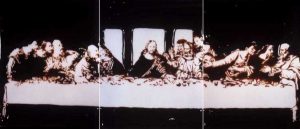
Or the Mona Lisa in PB & J:
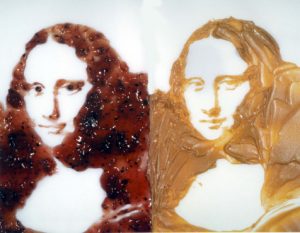
His glorious portraits of the catadores look like this:
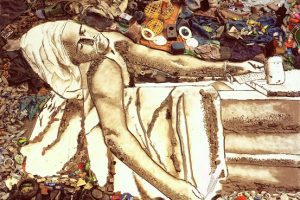
What you’re looking at is a photographic reproduction of a collection of things, a collector of things, and a collector of people, all in one incredible recreation of Jacques-Louis David’s famous painting, The Death of Marat (1793).
Muniz’s photo is an image of Tiaõ (Sebastiao Carlos Dos Santos), the young catadore who served as the energetic president of the ACAMJG at the time the film was made. Tiaõ has worked as a picker since he was 11 years old, and he was inspired to organize his co-workers when he read political texts that he found in the landfill. After years of collecting recyclable things, Tiaõ shifted his focus and began to bring people together, forming the union that changed the way many of the catadores felt about themselves and their vocation.
Muniz took his picture, posing him to resemble the murdered French revolutionary, and granting the young man the dignity he deserves. Here’s the before and after:

But the final image that you see at the right is not simply a picture of Tiaõ slumped over the edge of a bathtub. Muniz has recreated his contours with fragments of dust and other matter, sketching the human form out of rocks and bits of debris taken from the trash heap itself. In fact, all of the color and texture that surrounds the main figure is a collection of garbage, which Muniz arranged on the floor of a vast warehouse—around his “drawing” of Tiaõ—and then re-photographed to create the final work. By gathering all these things together, Muniz captures both the young organizer’s radical spirit and his tragic circumstances. The image’s link with David’s famous painting asks viewers to take Tiaõ seriously as a political figure, and the ensemble is definitely more than a sum of its parts.
What interests me the most about these photographs is the transformations that are made possible when things come together. By itself, each object in the image is a discarded, used-up piece of rubbish. By himself, Tiaõ is just another nameless, faceless, member of the Brazilian working poor. But when they come together—the materials that Tiaõ collects and the people that he gathers around him—something magical happens. In that moment of encounter, there’s a comingling of atoms, voices, vibrations and scents. Invisible transactions occur, and matter—both living and inert—is forever altered.
In many ways, the process of Muniz’s work is nearly as important as the final results. Here’s a shot of one of his catadore portraits in progress:
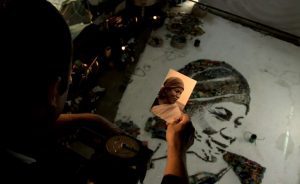
That’s Magna (Magna de França Santos), whose photo depicts her as a strong, proud, and hopeful figure. Magna came to be a catadore after her husband lost his job and she made a choice not to work as a prostitute. Here’s her before and after:
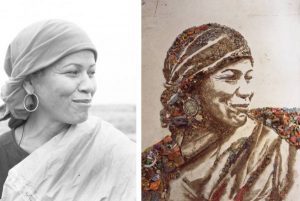
In the original photograph, her radiant face is surrounded by plain cloth; in Muniz’s collage, that drapery comes alive with the objects from her collection. Her humanity is so much more palpable in the midst of all that other stuff.
For me, Vik Muniz offers a model of what the Material Collective should strive to be. He transforms the stuff of life—even the dirty, messy, seemingly banal substances—into beautiful and moving things. Those things have real impact. They can affect honest and measurable change in the world. They have inspired many of the catadores to look beyond their circumstances, and I hope that they have also aroused distant viewers—like us—to look beyond our surroundings and work towards a universe that we would be proud to inhabit.
More than anything else, I feel a kinship with Muniz. His expression of the pickers’ pride, intelligence, strength, and beauty makes me feel guilt, powerlessness, and inspiration all at once. And, truthfully, isn’t that the perfect combination? Just enough guilt to make you feel ashamed of the accident of your birth, the cost of your education, and the overall cushiness of your life. Precisely the right amount of powerlessness: you have no hope of ever affecting real change for these particular people (especially at your age!), but still you want to rail against that ineffectuality and make some kind of difference in your own arena. And, just a dash of hope, enough to urge you on, force you up off the couch to DO SOMETHING.
So I’m writing this to ask you to pass it on, blog about it, bring it up in your classes. If Muniz’s photos can magically transform the basest of matter into the loftiest of ideas, maybe our work can also manifest some real change in the world. Maybe, if we work at it, we can bring things and people together in inspirational new ways.
